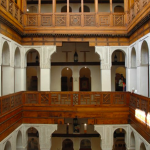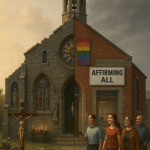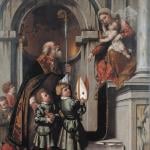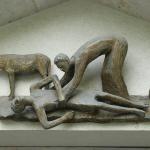Last updated on: August 28, 2015 at 10:20 pm
By
CNA Daily News
Vatican City, Aug 28, 2015 / 04:20 pm (CNA/EWTN News).- Earlier this year the Pontifical Council for the Family organized three seminars which gathered scholars to discuss marriage and family life in the run-up to the Synod on the Family being held in October. The lectures at these seminars were published June 2 by Libreria Editrice Vaticana in Italian as Famiglia e Chiesa, un legame indissolubile (Family and Church, an indissoluble bond), and feature a preface written by Archbishop Vincenzo Paglia, president of the Pontifical Council for the Family. On the whole, the book suggests a “penitential path” that would allow the divorced-and-remarried to receive sacramental Communion while still engaging in sexual relations. In a June 15 statement, the pontifical council said that “In view of the forthcoming Synod, we wanted to focus on some theoretical issues, identified as paradigmatic nuclei, crucial for the anthropological and theological reflection on marriage and family.” The three seminars, held Jan. 17, Feb. 21, and March 14, gathered 29 scholars to discuss “Marriage: Faith, Sacrament, Discipline”; "Family, Conjugal Love and Generation”; and "The Wounded Family and Irregular Unions: What Pastoral Attitude." The seminars were attended by Archbishop Paglia; his deputy, Bishop Jean Laffitte; and Bishop Fabio Fabene, undersecretary of the Synod of Bishops, though none of them took part in the discussion. The Pontifical Council for the Family noted that the “new, interesting book” includes, at its end, three brief summaries “that, building upon the issues raised during the debate, provide guidelines and prospects for reflection” on the topics of the three seminars. Notable among the experts invited to the seminars is Fr. Eberhard Schockenhoff, who teaches moral theology at the University of Freiburg and who also participated in the May 25 “shadow council”, which pushed for acceptance of contraception, homosexual acts, and Communion for the divorced-and-remarried. In one of his interventions at the seminars sponsored by the Pontifical Council for the Family, Fr. Schockenhoff stressed that “the possibility of an evolution of ecclesiastical doctrine on marriage is greater” than what can be suggested by “a statement that the Church cannot modify her praxis without betraying her traditions.” To this end, Fr. Schockenhoff asked for an updating of Familiaris consortio, the 1981 apostolic exhortation of St. John Paul II which was the fruit of the Synod on the Family held in 1980. The widest-ranging discussion was on the notion of sin and “unforgiveable sin.” Fr. Eduardo Scognamiglio, OFM Conv, a professor at the Southern Italy Theological Faculty, voiced hope that the Synod would “honestly discuss whether it is possible to deprive a member of the faithful of the Eucharist for all of his existence.” Given this, the seminars articulated a proposal for a “penitential path” that would eventually allow the divorced-and-remarried to receive Communion – even though the penitence would not necessarily include foregoing sexual relations with one's second “spouse.” In Familiaris consortio, St. John Paul II taught that “Reconciliation in the sacrament of Penance which would open the way to the Eucharist, can only be granted to those who, repenting of having broken the sign of the Covenant and of fidelity to Christ, are sincerely ready to undertake a way of life that is no longer in contradiction to the indissolubility of marriage. This means, in practice, that when, for serious reasons, such as for example the children's upbringing, a man and a woman cannot satisfy the obligation to separate, they 'take on themselves the duty to live in complete continence, that is, by abstinence from the acts proper to married couples.'” But Fr. Giampaolo Dianin, a professor of moral theology at the Theological Faculty of Triveneto, underscored that the 2014 synod's final report does not explicitly refer to the commitment not to engage in sexual relations with one's second “spouse”. He outlined a “penitential path” under the responsibility of the bishop – or his delegates – which would result in either full or “partial” admission to the sacraments. For Fr. Dianin, “partial” admission to Confession and Communion would occur only during the Easter season (and on special occasions). He grounded this proposal for “partial” admission to the sacraments in the precepts of the Church that Confession be made at least once a year, and that one receive Communion at least once a year, during the Easter season. These precepts are rooted in the Fourth Lateran Council, held in 1215. Fr. Dianin used the “Easter precept” to conclude that annual admission to Communion “cannot be denied to the divorced-and-remarried.” The same logic was used by Archbishop Paglia, who told Famiglia Cristiana Aug. 12 that “one must not forget what the Fourth Lateran Council (1215) established with its so-called 'Easter precept', that Communion and Confession at leat once a year are necessary in the economy of salvation. There is room to reorder in a more logical way both the discipline and the doctrine for a pastoral path that can find broad consensus.” Fr. Eugenio Zanetti proposed what he called a “path of conversion to love,” rather than a “penitential path”. This proposal would include a year of group prayer and reflection, intensified during Lent. At a Confession made during Holy Week, the divorced-and-remarried would be granted absolution so long as they intend to abstain from sexual relations with their second “spouse” during the Easter Octave; they would then be admitted to Communion on the Octave day, which is Divine Mercy Sunday. In stark contrast to majority of the group invited by the Pontifical Council for the Family stood Fr. José Granados, DCJM, who is vice-president of the Pontifical John Paul II Institute for Studies on Marriage and Family at the Lateran University. Fr. Granados emphasized that any penitential path must conclude in a separation from a new union, or, when that is impossible, in the choice not to engage in sexual relations. The group also discussed the issue of contraception, asking that the synod clarify the Church’s teaching on sexuality, overcoming what Fr. Gianluigi Brena, S.J. (a retired professor of the phenomenology of religion at the Aloisianum Philosophical Institute) called “an excessive severity and authoritarian regulations.” Fr. Scognamiglio said that natural methods for the regulation of birth “must not be absolutized” and that “at the upcoming synod a mature reflection on faith and moral issues should emerge. We cannot replace the choices of couples; we can only educate them to choose with wisdom and maturity in faith.” In general, the participants expressed a preference for natural means of the regulation of birth, but at the same time most showed an openness to discussing the issue of contraception. The assembled group agreed that the Church should commit to presenting more clearly her teaching on marriage, especially during marriage preparation; that she should counsel and assist troubled couples; and that she should show the divorced-and-remarried that they are still welcome. In the preface of the book, Archbishop Paglia wrote that “The Pontifical Council for the Family, in keeping with its statutory mandate, has responded to Pope Francis' call also through the promotion of an International Research Seminar on some issues mentioned in the Lineamenta for the next Synod of Bishops." This comes in contrast to Cardinal Ennio Antonelli (who preceded Archbishop Paglia as president of the Pontifical Council for the Family and is now retired) who published, in several languages, The Marriage Crisis and the Eucharist, a short book arguing that the divorced-and-remarried need the Church's support in conversion and spiritual growth – not a change in the practice on reception of Communion. Read more















